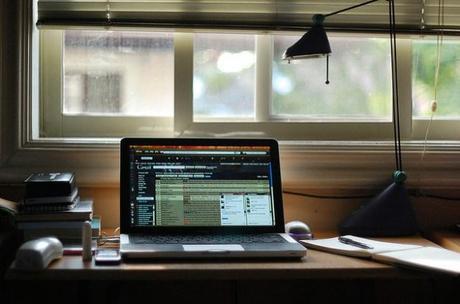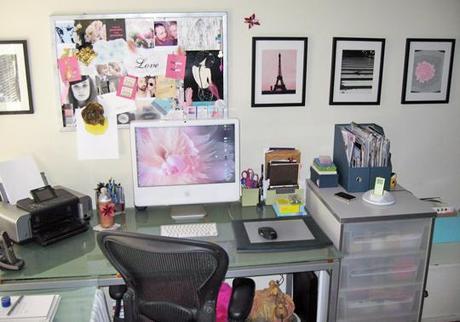
Photo from Flickr user Kathy Ponce.
As promised, here is the follow-up post to 4 Things to Consider When Assembling Your Home Office.
Studies have shown that the amount of people who work from home – whether it’s professional blogging, telecommuting, or some other job – has increased and will continue to increase. The prospect of working from the comfort of your own home is tempting, but success isn’t guaranteed if you choose this path. Don’t be deceived into thinking it’ll be as easy as waking up and sitting in front of your computer; it takes a lot of practice and personal drive.
You may find hundreds of articles or tip lists online with advice. Here are some of the suggestions many of them have in common.

Photo from Flickr user Noodles and Beef.
1. Get dressed. Don’t just spend the day working in your pajamas. When you wake up in the morning, take some time to shower and get yourself ready like you would on a normal day. This doesn’t necessarily mean putting on business attire, however. Aim for an outfit that’s both presentable and comfortable.

Photo by Flickr user Maegan Tintari.
2. Create a work space. Whether it’s an office in a separate room, a workstation, or simply a desk, set aside a specific place that is strictly for work. This lets your brain know that it’s time to concentrate and get serious. Attempting to get work done in front of the TV or some other potentially distracting environment is not a good idea.

Photo by Flickr user Simon Shek.
3. Set your hours. While working from home does offer a lot of flexibility, it’s good to create a schedule for yourself to work within, like you would have if you were going to a conventional office every day.

Photo by Flickr user makelessnoise.
4. Develop a routine. Let this schedule flow into a daily routine. This should include work hours, meal times, breaks, time with friends or family, and plenty of time to sleep at night.

Photo by Flickr user ~ezs.
5. Keep to-do lists. Write out daily and weekly priorities so you have goals to work toward. This will encourage productivity.

Photo by Flickr user Caitlin Regan.
6. Don’t forget to take a break. For some people, it’s tempting to take frequent breaks. Others are more prone to get completely engrossed in a project and lose track of time. Don’t let your work consume you; step away for a little while.

Photo by Flickr user Lisa @ Sierra Tierra.
7. Maintain a good balance of work and life. Just as some people are bad at remembering to take breaks, some will let work dominate most of their waking hours or continue working late into the night. Once your set hours are over, put your work down and don’t pick it back up until the next day.

Photo by Flickr user EvelynGiggles.
8. Cut down on clutter. Try to keep your work space organized and tidy.

Photo by Flickr user Brad Montgomery.
9. Set boundaries. Communicate your hours to your family and friends; make sure they know that you are not to be disturbed during that time unless it’s important.

Photo by Flickr user Roger Braunstein.
10. Keep healthy. Because you are working from home, you won’t be as active. Try to make time each week to exercise. Eating healthy is also important. Many experts have recommended only eating in the kitchen, not at your work space, and keeping water on hand when you’re working.

Photo by StockMonkeys.com.
11. Network electronically. Join forums, social networking groups, or other online communities and participate often. Important business connections can be made through these platforms.

Photo by Flickr user Charleston’s The Digitel.
12. Change your environment. Sometimes being cooped up in your house for too long can leave you restless and easily distracted. Get out of your house and bring your work with you; sometimes a change of scenery can be refreshing.

Photo by Flickr user Digitpedia Com.
13. Consider investing in noise-cancelling headphones. If you really need help focusing, using noise-cancelling headphones could prove to be beneficial.
Do you have any tips of your own to add to this list? Share your thoughts in the comments below!

